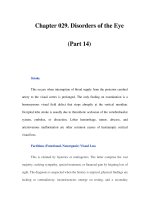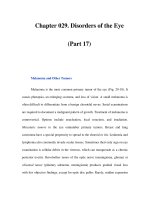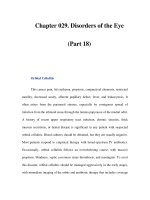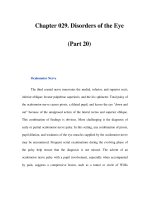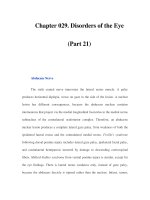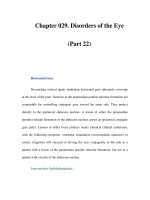Chapter 029. Disorders of the Eye (Part 16) pps
Bạn đang xem bản rút gọn của tài liệu. Xem và tải ngay bản đầy đủ của tài liệu tại đây (32.33 KB, 5 trang )
Chapter 029. Disorders of the Eye
(Part 16)
Central Serous Chorioretinopathy
This primarily affects males between the ages of 20 and 50. Leakage of
serous fluid from the choroid causes small, localized detachment of the retinal
pigment epithelium and the neurosensory retina. These detachments produce acute
or chronic symptoms of metamorphopsia and blurred vision when the macula is
involved. They are difficult to visualize with a direct ophthalmoscope because the
detached retina is transparent and only slightly elevated. Diagnosis of central
serous chorioretinopathy is made easily by fluorescein angiography, which shows
dye streaming into the subretinal space. The cause of central serous
chorioretinopathy is unknown. Symptoms may resolve spontaneously if the retina
reattaches, but recurrent detachment is common. Laser photocoagulation has
benefited some patients with this condition.
Diabetic Retinopathy
A rare disease until 1921, when the discovery of insulin resulted in a
dramatic improvement in life expectancy for patients with diabetes mellitus, it is
now a leading cause of blindness in the United States. The retinopathy of diabetes
takes years to develop but eventually appears in nearly all cases. Regular
surveillance of the dilated fundus is crucial for any patient with diabetes. In
advanced diabetic retinopathy, the proliferation of neovascular vessels leads to
blindness from vitreous hemorrhage, retinal detachment, and glaucoma (see Fig.
338-9). These complications can be avoided in most patients by administration of
panretinal laser photocoagulation at the appropriate point in the evolution of the
disease. For further discussion of the manifestations and management of diabetic
retinopathy, see Chap. 338.[newpage]
Retinitis Pigmentosa
This is a general term for a disparate group of rod and cone dystrophies
characterized by progressive night blindness, visual field constriction with a ring
scotoma, loss of acuity, and an abnormal electroretinogram (ERG). It occurs
sporadically or in an autosomal recessive, dominant, or X-linked pattern. Irregular
black deposits of clumped pigment in the peripheral retina, called bone spicules
because of their vague resemblance to the spicules of cancellous bone, give the
disease its name (Fig. 29-17). The name is actually a misnomer because retinitis
pigmentosa is not an inflammatory process. Most cases are due to a mutation in
the gene for rhodopsin, the rod photopigment, or in the gene for peripherin, a
glycoprotein located in photoreceptor outer segments. Vitamin A (15,000 IU/day)
slightly retards the deterioration of the ERG in patients with retinitis pigmentosa
but has no beneficial effect on visual acuity or fields. Some forms of retinitis
pigmentosa occur in association with rare, hereditary systemic diseases
(olivopontocerebellar degeneration, Bassen-Kornzweig disease, Kearns-Sayre
syndrome, Refsum's disease). Chronic treatment with chloroquine,
hydroxychloroquine, and phenothiazines (especially thioridazine) can produce
visual loss from a toxic retinopathy that resembles retinitis pigmentosa.
Figure 29-17
Retinitis pigmentosa with black clumps of pigment in the retinal periphery
known as "bone spicules." There is also atrophy of the retinal pigment epithelium,
making the vasculature of the choroid easily visible.
Epiretinal Membrane
This is a fibrocellular tissue that grows across the inner surface of the
retina, causing metamorphopsia and reduced visual acuity from distortion of the
macula. A crinkled, cellophane-like membrane is visible on the retinal
examination. Epiretinal membrane is most common in patients over 50 years of
age and is usually unilateral. Most cases are idiopathic, but some occur as a result
of hypertensive retinopathy, diabetes, retinal detachment, or trauma. When visual
acuity is reduced to the level of about 6/24 (20/80), vitrectomy and surgical
peeling of the membrane to relieve macular puckering are recommended.
Contraction of an epiretinal membrane sometimes gives rise to a macular hole.
Most macular holes, however, are caused by local vitreous traction within the
fovea. Vitrectomy can improve acuity in selected cases.

